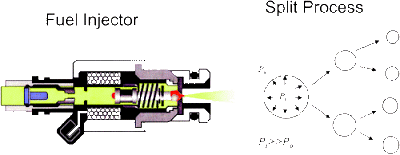
Emitted droplets from an electrified fuel injector split to become smaller and smaller.
A small device (less than $200 to produce) placed just before the fuel injection for the engine, producing a strong electric field to reduce the fuel viscosity, resulting in much smaller fuel droplets in atomization. Because combustion starts at the droplet surface, smaller droplets lead to cleaner (10 times less particulate pollution) and more efficient combustion. Both laboratory tests and road tests confirm our theory and indicate that such a device improves fuel mileage significantly (mileage increased up to 19%). The technology is expected to have broad applications, applicable to current internal combustion engines and future engines as well.
Widely applied if it saved 10% of fuel usage it would saved the US over $70 billion/year in oil. Only a little over half of the oil used in the USA is for cars and trucks the rest is for industrial processes, heating, planes, trains, ships.
The technology, developed on the new physics principle, consumes very small power and improves fuel efficiency significantly, we expect it will have wide applications on all types of internal combustion engines, present ones and future ones. By adjusting the values for the electric field and time duration, we could make this technology work effectively for other fuels, such as biodiesel, kerosene, and gasoline.
An electric field makes diesel thinner because some molecules in the fuel become charged and aggregate together, reducing their overall surface area. That means less friction between them, and a less viscous fuel. Tao and colleagues believe fuel efficiency gains were lower under stop-start urban driving conditions because the rate at which fuel flows through their device constantly varies. They are working on a version that varies its electric field to match fuel flow rate and keep viscosity constantly reduced in stop and go traffic.
Matt Thomas of CFD Research Corporation works on similar fuel electrification techniques. He says fitting the device to new cars will not produce such spectacular efficiency gains, but adds that it would still cut emissions.
Being able to retrofit existing diesel engine cars and trucks with this device would reduce overall oil usage by 2% in the USA. 10% of oil is used for diesel fuel cars and trucks in the USA. This technology would reduce European fuel usage by over 5% because of the higher diesel fuel usage. Assuming that the technology will work on other fuel types then the overall fuel consumption could be reduced by 10% or more. The cost to apply it the 100 million most highly used cars and trucks would be $20 billion. Saving 10% of oil usage in the USA would be 2 million barrels per day. The savings would be 200 million dollars per day assuming $100 per barrel for oil. This would be over $70 billion dollars per year.

(a) Installation of the device on the Cornaglia Iveco diesel engine.
(b) Installation of our device on Mercedes-Benz 300D, a diesel sedan.

Brian Wang is a Futurist Thought Leader and a popular Science blogger with 1 million readers per month. His blog Nextbigfuture.com is ranked #1 Science News Blog. It covers many disruptive technology and trends including Space, Robotics, Artificial Intelligence, Medicine, Anti-aging Biotechnology, and Nanotechnology.
Known for identifying cutting edge technologies, he is currently a Co-Founder of a startup and fundraiser for high potential early-stage companies. He is the Head of Research for Allocations for deep technology investments and an Angel Investor at Space Angels.
A frequent speaker at corporations, he has been a TEDx speaker, a Singularity University speaker and guest at numerous interviews for radio and podcasts. He is open to public speaking and advising engagements.

